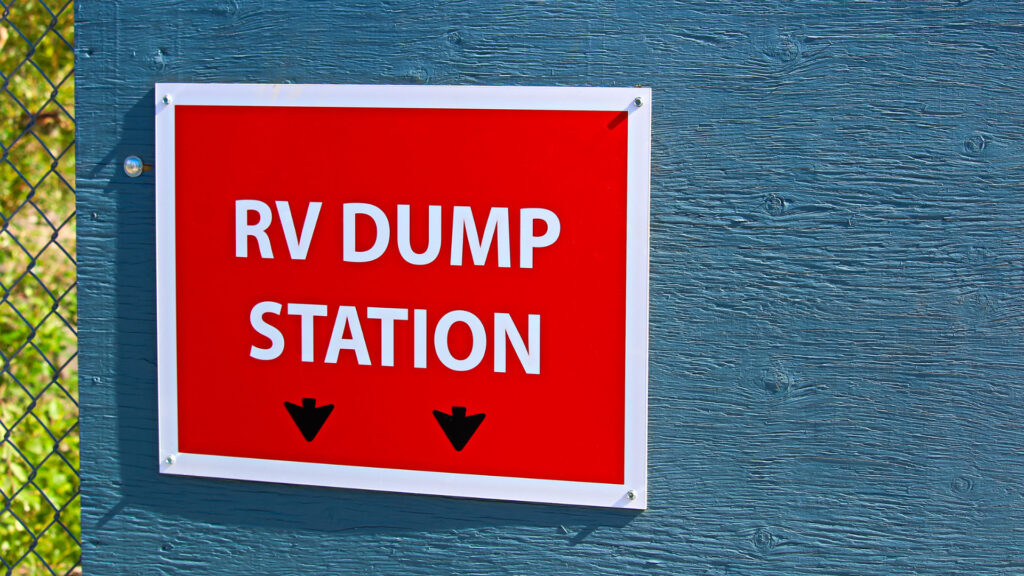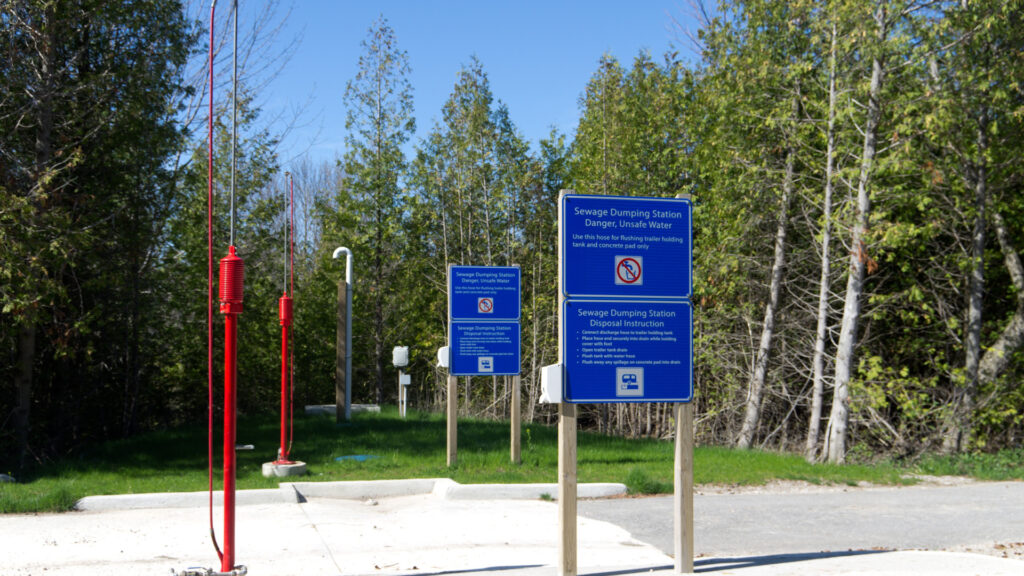



If you’re fully using your camper, you’ll eventually need to empty your waste tanks. But can you dump your RV waste in a septic tank?
Dumping at a campground’s dump station can mean sitting in a long line. Additionally, it can feel stressful to empty your tanks with an audience. You don’t want to be that person who makes a mistake at the dump station.
If you’re hurrying to get home, you may want to consider all your options. So can you dump RV waste in a septic tank? Let’s see!
Septic tanks are massive containers that treat and store wastewater from homes or businesses not connected to a sewer system.
They use a natural process, which relies on the tank and soil bacteria to break down organic matter. In addition, the process reduces the number of harmful pathogens and pollutants.
These are common wastewater solutions in rural areas or other locations without sewer systems.
Septic tanks use a natural process for separation, treatment, and discharge. During the first process, separation, the waste gets sorted into solids, scum, and liquid.
Naturally, the solids sink to the bottom, and lighter materials float to the surface and create a layer of scum.
The middle layer, the liquid, relies on bacteria in the septic tank to break it down. This drastically reduces pathogens and pollutants in the wastewater before releasing the waste into a drain field. Once in the drain field, the water gets absorbed into the ground, naturally purifying the water.
Unfortunately, septic tanks require a delicate balance of bacteria and other organisms to function properly. Occasionally, owners must maintain their septic tank by pumping out the sludge and scum to avoid buildups.

Unfortunately, the rules and regulations regarding dumping your RV waste in a septic tank can be confusing. Just because you have a tank on your property doesn’t mean you can legally dump in it. Laws can vary from state to state and county to county.
Before you go dumping your tanks at home, it’s important to check the laws specific to where you live. You don’t want to find yourself on the receiving end of a massive fine for illegal dumping.
We recommend contacting the local municipality or town office to inquire about the regulations. If they don’t have an answer, they may provide guidance to help you find an answer.
Or you may get passed on to the local health department or code enforcement. Once you get an answer from them, it can help to get documentation in case anyone challenges you for dumping your tanks into your septic tank.
After confirming that you can legally dump your RV tanks in your septic tank, it’s rather easy to do. However, you must follow a certain process to avoid potential issues. Let’s take a look!
First, locate the cleanout pipe. These are usually PVC pipes that stick several inches out of the ground. You’ll connect your RV to dump your tanks from this point.
Your cleanout pipe will typically be somewhere around the base of your home. If you see a pipe sticking up from the ground near your home, that’s likely the cleanout pipe.
However, we strongly suggest you check with a professional if you have any doubts. You don’t want to dump the contents of your black tank into a random pipe.
Once you’ve confirmed you’ve found the cleanout pipe, you can connect your RV to it. The length of sewer hose you’ll need will greatly depend on the location of your sewer connection.
First, connect a clear elbow attachment to your sewer hose and then connect it to the cleanout pipe.
Then run the hose back to the sewer connection on your RV and check to ensure your sewer valves are closed.
When removing the sewer cap, it’s a good idea to catch any liquids or drops with the sewer hose. This can help avoid getting anything on the ground.

Ensure your connections are tight, and then dump your black tank first. Many RVers will open their gray tank for five to 10 seconds to test their connections. If you’ve not connected something correctly, it’s better to find out with gray water than the contents of your black tank.
Once you’re sure everything is good to go, you can fully open your black tank. Take your time and drain the tank completely. Rushing this process will only leave gunk in the bottom of your tank.
When the black tank has emptied, you can close the valve and repeat the process with your gray tanks.
Don’t forget to flush your black tanks regularly. If you can dump your RV waste at home in a septic tank, this makes it much easier. If there will be more than two or three weeks between uses, we recommend flushing your tanks at the end of each trip.
Flushing your tanks can help keep them clean and prevent odors from entering your RV. If you have an RV with a black tank flush connection, it’s a simple task that requires minimal effort.
Those without the luxury of this connection will need to run water through their toilet or use a hose to fill their black tank with water quickly.
One important step you can’t overlook is closing the tank valves. Unfortunately, we know several RVers who have skipped this step at some point or another. You hope never to make this mistake, but if you do, you hope you only make it once.
When you leave your tank valves open, you’re in for a surprise the next time you go to dump your tanks.
The liquids will fill the sewer drain pipe, and the sewer cap is the only thing holding them back. When you remove the sewer cap, the tank’s contents will spill out onto you, the ground, and anything in the area.
Keep in Mind: Is It Safe to Drive an RV With a Full Water Tank? Let’s find out!
You’ll still need to dump your tanks even if you don’t have a sewer connection at home. Luckily, a handful of other places allow you to dump your RV tanks. Let’s learn more!
Campgrounds are among the most common places for RVers to dump their tanks. Many don’t realize that some campgrounds will allow non-guests to use the dump station for a small fee.
This is great if you hope to avoid expensive camping fees by boondocking in the area. It may cost you $10 or $15, but you can empty and fill up your tanks with potable water.
We recommend calling ahead and asking if the campground will allow you to dump your tanks and fill up on water. Some campgrounds are less hospitable than others and only allow guests to use their facilities. However, a majority of campgrounds will happily take your money.
Over the last several years, many truck stops have begun catering to RVers. Many of these facilities install RV-specific fuel lanes that include just about everything RVers could need, such as a dump station. Some offer discounts if you’re a member of their loyalty program or a member of a club like Good Sam.
Unfortunately, the truck stops that offer these services can be hit or miss. We’ve had tremendous luck with checking the truck stop apps to know what services they provide.
So download the apps for your favorite locations to take advantage of all their amenities during your travels.

It’s always a pleasant surprise when you pull into a rest stop and see that they offer a dump station. Many of these state-run facilities are free to use.
We’ve stopped numerous times at rest stops to dump our tanks and found it very convenient. Because these facilities can handle big rigs, RVs of any size can easily get in and out.
While you may think RV dealerships are only good for buying an RV and overpriced accessories, that’s not always the case. Many RV dealerships have septic tank dump stations customers can use.
We recommend calling ahead and inquiring with each store to ensure it’s a service they offer. Dealerships want you to have a pleasant experience and think kindly of them so they can earn your business for your next RV purchase.
Pro Tip: Before you head over to a communal dump station, make sure you know about these Unspoken RV Dump Station Rules
Many people overlook city and county sewer treatment facilities when they need to dump their tanks. Unfortunately, these may not always be the easiest for larger rigs to access because they may be in town, which can be dicey for big rig drivers.
Call ahead to confirm the service is available if you go this route. If it is, ask for any specifics about where you should park or how to access the dump station.
Do your research, especially if you’re in an unfamiliar area, and scout out any low clearances or any other issues that could pose a risk for you and your rig.
Dumping your tanks is an inevitable part of RVing. If you have a septic tank at home, it can be a much less stressful experience dumping your RV tanks here. However, just because you have a septic doesn’t mean you can always dump your tanks at home.
Check the legal requirements and know how to dump your tanks properly. If you damage your septic system, it could be a very costly mistake.

